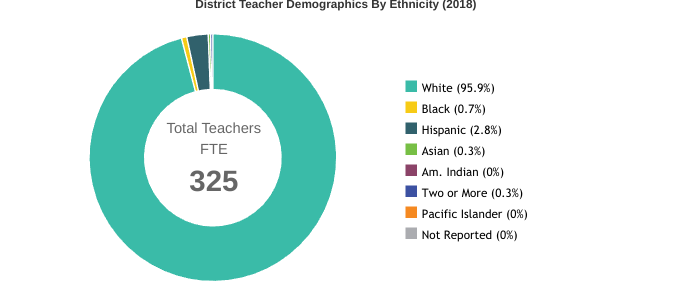DGS staff continues to misrepresent diversity of student body
The DGS teaching staff consisted of 95.9 percent of white teachers, while the student body consisted of 58 percent of white students.
On Sept. 14, 2018 I, Ariel Oh, asked a question that was never answered:
Well, maybe it was answered but simply never solved.
In one calendar year, DGS has gone through many changes. From new ice cream freezers to an entire reconstruction plan, the school district has done plenty of busywork in order to improve the look of the building and grounds. But what has changed about our staff?
The answer is not really anything at all.
According to the Illinois Report Card, the 2018-19 school year at DGS consisted of 95.9 percent white teachers, 0.7 percent black, 2.8 Hispanic and 0.3 percent Asian. There is no 2019-20 data, but with such a large percentage of the teachers being white, a couple of new people of color wouldn’t change the numbers much.
0.7, 2.8 and 0.3 percent compared to 95.9? Weak.
I personally believe that connection is an important part of school. Students connect with so many things in school (subjects, sports, clubs, etc.). But I think the most important thing we connect with at school is people.
By having a primarily white teaching staff (or staff in general), teachers might not be able to always recognize cultural differences and provide a “safe” or more welcoming class environment for students. It can be hard for some students to feel comfortable within their class environment as they have nobody to relate or connect to.
With connection comes trust. With trust comes effective learning and a better willingness to learn.
A social studies teacher once told me that people bring their ideas with them — I believe that. Year after year, I would go on thinking that I could only be a certain type of person because of my race. I believe what students see at DGS influences them as young, impressionable teens. What we see is what we know.
How come I mainly see Asians working in the tech department, Hispanics working within security and very few black teachers? While there are teachers of color within the staff, the school re-enforces racial stereotypes as to what a student’s particular race can achieve in the workforce. It shows that we as a society still have many racial barriers to break.
Plain and simple: District 99 needs to do a better job of hiring more people of color and retaining them within the staff.
The root of this problem could be that there are not any open positions, that there is a lack of minority candidates applying to work at DGS or simply that minorities who apply just don’t have the qualifications. Another question I have is what is our staff doing in order to welcome people of color into our school — working as teachers, administrators, janitors, etc.
I have learned through the voices of numerous teachers that DGS is in fact trying to implement more diversity in our school. We have clubs such as Cultures in Alliance, and hold workshops about creating school change in order to include every minority group at DGS. We even have a class available to students based on understanding the origins of racism and what it is today.
However, I feel that if the same people are in charge, and nothing has been changing, that is also a possible problem as to why change isn’t happening. These are exceptional opportunities that were made for students to engage in, but what does that change about our staff?
In 2018, District 99 recruited four minority teachers out of 24 potential candidates. In 2019, they hired eight minority teachers out of 28 potential candidates. Although there was an improvement, the fact of the matter is only 8 minority teachers within DGN and DGS combined isn’t inclusive enough for a teaching staff of over 100 people for both schools.
For example, out of the 12 people in administration, nine are white.
I will ask you, do you think this represents our student body?
I understand change is difficult, especially when it comes to creating more diversity within a staff of well over 100 people. However, change is necessary in order for students to feel included, recognized and understood, especially since society is evolving to become more aware of race-related issues.
I, Ariel Oh, asked a question that was never answered.
Who will answer it now?




Jill Browning • Oct 22, 2019 at 10:43 am
Hello Ariel,
District 99 could not agree more with your assessment that we have a lot of work to do when it comes to creating a more diverse workforce, and one that better reflects our student body. In fact, we presented about this topic and all that we are working on to our Board of Education at the October 21, 2019 meeting. You can see the full presentation we shared at https://bit.ly/2Bw2krK.
At the meeting, we shared some of the obstacles we are experiencing to recruiting a diverse staff, some of which you identified in your article. The fact is that there are fewer people overall going into education, favoring higher salaries found in other fields, which reduces the overall pool of minority candidates.
Even so, we have taken numerous steps to aggressively recruit minority candidates to come to our schools. We are active participants at job fairs, in Illinois and surrounding states. We have closely examined our hiring practices, and trained hiring managers how to identify and reduce biases. We’ve used social media to reach those candidates who may not find us through other channels, so that we can share our story (see http://www.csd99.org/boe/equity-and-inclusion of a history of our past and current efforts). In addition to these initiatives, we are exploring ways to encourage our own students to pursue careers in education, which can also serve to possibly hire them into our district in the future. For example, we have an “Intro to Teaching” class that exposes students to the field and places them into local elementary and middle schools to further their experience. You can see a video of this class at https://www.youtube.com/watch?v=p8J__Jy6-fM&t=8s.
Our efforts have resulted in interviewing record numbers of minority candidates, and it’s starting to translate into new hires. For this year, we hired eight new minority certified staff members in the district, up from four in 2018-19.
We know we have a long way to go, but we believe that our efforts across the district to become more aware of equity and inclusion issues will advance our goals. Last year, all staff participated in training and this year, 350 students are being trained to lead all students in this important work.
We appreciate your criticism, insights and ideas, as we work to build a more diverse and inclusive environment. If you’d like to speak to someone in charge of hiring and diversity at our district office further, please let me know.
Thanks again!
Jill Browning
District 99 Communications
jbrowning@csd99.org
Joe Mama • Oct 21, 2019 at 7:06 pm
This is overall poorly written. As an eleventh grader, you should command a higher level of argumentative writing that can actually withstand debate and not depend on the flimsy shield of opinion. You have failed to comprehend the issues that are presented to prospective teachers. Kids in Chicago cannot even go to school due to the CPS teacher strike. Be thankful for what you have.
Rhaya Truman • Oct 21, 2019 at 3:07 pm
Great article Ariel! I loved the layout of this piece and the artistic twist. District 99 has improved in some areas but definitely has a long way to go when it comes to representation in staff as well as correctly identifying the true problems. Let me know if someone answers your question 🙂